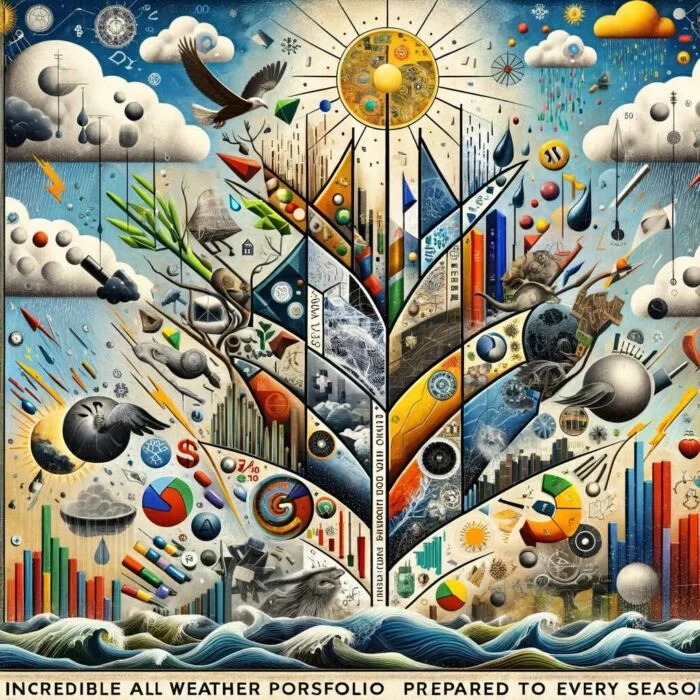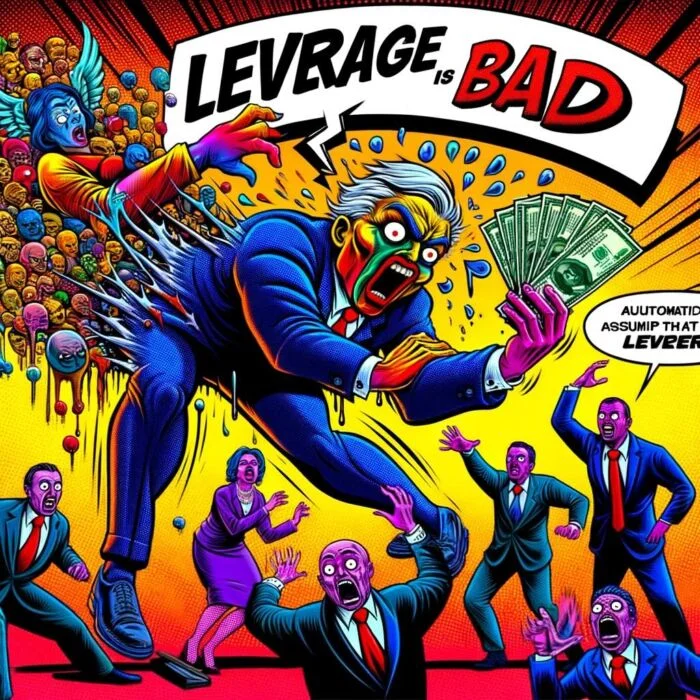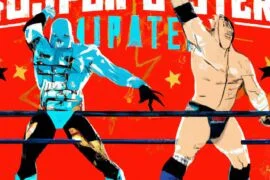On a personal level, one of my favourite investing strategies to learn more about these days is Trend Following.
I couldn’t think of a better person to interview on the topic than Eric Crittenden of Standpoint Funds.
As the creator of the highly successful all-weather fund BLNDX / REMIX, Eric thinks differently about asset allocation, risk-management and diversification than what would be considered industry standard.
By “industry standard” I mean anything deviating away from a portfolio composed exclusively of market-cap weighted stocks and aggregate bond index funds.
Oddly enough “all weather” portfolio solutions are relegated to the category of alternative investing styles.
This seems to me “certifiably insane” but at the same time I feel it offers an advantage to inquisitive investors who are interested in learning more about the subject with the potential willingness to divagate from the herd.

With this in mind, we’ll focus our discussion on contrarianism, trend-following, all-weather investing and alternative investing strategies as the main topics.
I greatly appreciate Eric taking the time to do this and the level of detail put into answering each of these questions.
I personally learned a lot and I think you will too.
Without further ado…let’s kick things off!

Eric Crittenden of Standpoint: All Weather Investing and Trend Following

Hey guys! Here is the part where I mention I’m a travel vlogger! This living legends interview series is entirely for entertainment purposes only. This is not financial advice. Do your own due diligence and research. Consult with a financial advisor.

Seriously, I’m a YouTuber not a financial professional, so take what I say with a grain of salt; okay? Cheers! 

These asset allocation ideas and model portfolios presented herein are purely for entertainment purposes only. This is NOT investment advice. These models are hypothetical and are intended to provide general information about potential ways to organize a portfolio based on theoretical scenarios and assumptions. They do not take into account the investment objectives, financial situation/goals, risk tolerance and/or specific needs of any particular individual.
The Origin Story: How Eric Got Started
Q1) Thanks for taking the time to take part in this ‘investing legends‘ interview Eric.
I’m in a fortunate position editing travel videos and running websites that I can often listen to podcasts while still being able to maintain focus on certain tasks.
I’ve been listening to 2-3 hours of investing podcasts almost daily for over a year now and you’ve become one of my favorite guests.
I’ve heard your podcast on the Meb Faber Show, Flirting with Models and Resolve Riffs to name a few.
I know a bit about your background story at this point but could you tell readers how you ended up stumbling into trend following investing in Kansas to now running one of the most exciting new alternative mutual funds BLNDX / REMIX with Standpoint in Arizona?
A1) Back in the mid 1990’s, while studying finance and computer science at Wichita State University in Kansas, I took one of my class projects to an extreme. The project was to implement modern portfolio theory from scratch to build the “optimal portfolio”.
At the time I had several friends who worked for large commodity trading firms who were able to provide me with historical returns on various hedge fund and alternative strategies.
One style, trend-oriented global macro, appeared to be the most important ingredient in an optimal portfolio.
I say this because it was the only approach that consistently delivered positive historical returns when stock and/or bonds struggled; especially when stock and bonds struggled at the same time.
When I shared my findings with professors and peers, I was perplexed by their lack of interest in such a seemingly valuable insight.
After college I had a few jobs, including working for a local financial advisor, and as a portfolio manager at a large family office.
It didn’t take me long to realize that I’d never be satisfied without being a part of the strategic planning of any process I’m contributing to, not just a highly compensated cog in the wheel.

Eventually I left Kansas with the following priorities: A) No tornadoes, B) No blizzards, C) Lots of sunshine, D) Start a fund that I’d be willing to put my own money in.
I ended up in Phoenix, Arizona and I’ve yet to see a tornado. The word “blizzard” is not in the local dialect.

Here in Arizona I worked on the trade desk for a local hedge fund, cofounded a hedge fund of funds, and cofounded a mutual fund company.
Eventually, still somewhat unsatisfied, I took two years off with the goal of designing my dream job; something I could stick with all the way into retirement.
Two years of no deadlines or pressure is an amazing opportunity to achieve clarity of thought and come up with a strategic plan.
Building my own version of the “optimal portfolio” and the creation of Standpoint Asset Management is the result of that plan.
Source: Flirting with Models on YouTube

Contrarian Investing: Daring To Be Different
Q2) Before we get specifically into trend following, I wanted to make a statement saying of all the subject areas I’ve ever studied, there maybe isn’t any easier pathway to being contrarian than investing.
Any sort of deviation from what I like to call milquetoast market-cap weighted stocks funds and aggregate bonds starts pushing you into contrarian territory.
As someone who has cobbled together maybe 2000 hours of research into investing in the past two years (but otherwise didn’t pay a lot of attention in previous years) is this an accurate perception?
Is the mere fact you’re known as a trend-following expert with decades of experience (and with an impressive track-record) contrarian in and of itself?
A2) In my experience, U.S. investors are almost exclusively focused on stocks, bonds, and real estate. Meaningful exposure to anything outside of these asset types can be described as somewhat contrarian. It certainly has been in my experience up until now.
Trend-oriented approaches that participate in global assets like metals, grains, livestock, currencies, energy, soft commodities, etc. are technically not new, but they feel that way to most investors that have relied on stock & bond portfolios since Reagan was president.

Contrarian Alternative Asset Allocation
Q3) I suppose I’m naturally biased to be attracted to contrarian investing given I’ve lived somewhat of a contrarian lifestyle. I’ve spent more of my adult years abroad than back home.
Nomadic and on the road is a more interesting and comfortable lifestyle for me than being at home most of the time.
It wasn’t until I was about 1500 hours into studying investing that I started to really fall down the rabbit hole and realize there were more investing options than merely stocks and bonds.
I played around with Portfolio Visualizer and realized you could improve your Sharpe ratios and Sortino ratios by diversifying between asset classes and by adding alternative investments.
What is it that is keeping the average DIY investor, the average professional investor and everyone in between from realizing that portfolios steeped in tradition are not necessarily the most optimal?
A3) Historically, stock & bond portfolios have been effective in falling interest rate environments. There is a reason people view their bond holdings as a hedge against stock market declines.
Since the 1980’s they’ve observed bonds produce positive returns when stocks struggle.
They don’t see or feel the need for any further diversification. However, what they are missing is the experience of a period of inflation/stagflation (like the 1970’s).
In a rising interest rate environment, stock and bonds can lose value at the same time, and for extended periods of time.
Few investors are prepared for such an environment.

Beyond this, the convenience factor has been a huge hurdle for decades. Only recently have normal investors been able to access effective (my opinion) alternative investments.
The large, entrenched financial services firms are not in the business of optimal portfolios.
They are in the business of standardized and scalable portfolios that allow them to extract profit margins from infrastructure they’ve built over the past couple decades.

BLIND TASTE TEST
Q4) I thought we could wade into the territory of trend following by highlighting the incredible Blind Taste Test video you created with the results of various single and multi asset classes annual returns, annual volatility and worst year.
You could only see the numbers not knowing which asset class or combined asset class it was.
During one of your podcast appearances you talked about it and I then went and found it on YouTube.
We’ll embed it here for people to watch before we continue with the question: (readers: please watch it!!!)

Source: Standpoint – Blind Taste Test on YouTube (The investment performance results presented here are based on historical backtesting and are hypothetical. Past performance, whether actual or indicated by historical tests of strategies, is not indicative of future results. The results obtained through backtesting are only theoretical and are provided for informational purposes to illustrate investment strategies under certain conditions and scenarios.)
What was it like when people saw the results? Was it paradigm shifting for some when they picked stocks/trend over equities, bonds, trend and stocks/bonds or did they just shrug their shoulders and go meh?
A4) When the asset classes were anonymized and blended together, nearly everyone chose to put half their portfolio in trend-oriented strategies.
But they weren’t happy about it once the assets were revealed.
It turns out that most people, financial advisors included, love diversification when all the ingredients are blended together, like a good bowl of chili.

However, when they are forced to evaluate each individual ingredient on a “line by line” basis, they start to feel uncomfortable with anything not related to stocks or bonds.
The blind taste test was a novel way of forcing people to acknowledge that trend-oriented strategies have been even better diversifiers than bonds.

Why Consider Trend Following?
Q5) Now that we’ve firmly established trend-following not only has a place in the portfolio but that it can potentially pair better than even stocks/bonds let’s get into the ‘why’ part of the equation.
What in particular about a long only equity strategy paired with trend-following creates ideal long-range returns?
A5) The extreme diversification and flexibility of a typical global trend-following strategy deserves some respect.
At any given time, a trend-oriented approach can be long or short nearly 100 different markets including precious metals, industrial metals, grains, soft commodities, energy markets, currencies, interest rates, even foreign equity and bond markets.
That’s a lot of flexibility to adapt to a lot of different market conditions.
While bonds can be an excellent diversifier in a falling interest rate environment, I think a well-designed trend-oriented approach is likely to add more value across a wider range of potential environments.
Case in point, bonds have not helped stock portfolios since Standpoint has been in business (Jan-2020), while trend-oriented approaches have added a lot of value.

Trend Following 101 For Beginners
Q6) For readers curious about trend-following but not quite up to speed with all of the terminology can you help us distinguish between the following: trend following, managed futures, cta, macro
A6) Trend-following: the act of following a structured plan to buy assets that have trended higher in value, short assets that have trended lower in value, and liquidate assets when their trends fail/reverse, all subject to some form of a total portfolio risk budget.
Managed futures: the asset class, or industry, in which most trend-following strategies exist. Not all strategies in the managed futures industry are trend-following in nature.
CTA: stands for commodity trading advisor. This is the designation given to the person/firm that manages the trend-following strategy. Most of them trade more than just commodities, but back when the term was first established, commodities were the primary markets traded.
Macro: a general term taken to mean large-scale or global in nature; also willing to invest long or short.

Top 3 Trend Following Tips
And for investors wanting to try trend-following themselves for the first time, are there 3 tips you could suggest for building an effective trend-following strategy out of the gate (without having to learn all of the painful mistakes of trial and error along the way)?
Three tips? It’s tough to narrow it down.
1) Respect the severe limitations of backtests
Modern computers are very good at torturing data until it shows you what you want to see. Optimizing a trend-following system (or any system) with a large number of rules/variables will almost certainly produce beautiful historical results but likely disastrous real-life results going forward.
The phenomenon is called “curve fitting” and until you learn to resist this temptation, you are firmly in the danger zone.
Familiarize yourself with the term “robustness” and strive to understand why too many rules/variables lead to fragility.

2) See the whole forest, not just the trees
A complete trend-following system identifies which markets to monitor, when to buy and how much to buy, when to sell and how much to sell, all while regulating how much total risk is being taken across the whole portfolio.
Don’t spend a disproportionate amount of time on entry methods (when to buy); novices tend to waste years on this seductive feature, at the expense of the big picture.
3) Always ask yourself “why?” a simple trend-following system should work
Few people agree with me on this topic, but it is absolutely essential in my opinion.
If you plan to run a trend-following system, and extract wealth from the markets in a risk-managed, reasonably consistent manner, why should you be able to do that?
Are you smarter, faster, better-connected than the thousands of PhD’s using super-computers and artificial intelligence in the hedge fund industry?

I’m not, and it doesn’t bother me. I say this because I believe I have an edge that the industry can’t replicate.
There is no single word for it, but it’s a combination of realistic expectations, discipline, and healthy incentives.
I sincerely believe that a globally diversified, simple but durable, trend-following approach effectively provides liquidity to the large group of market participants that are “willing and able” to lose money to me, the “hedgers”.
I also believe they are economically better off for losing money in the markets since their hedge positions should be negatively correlated to their core business.
If you own car insurance, you own a hedge, and you are not better off getting into a wreck. Thus, you should be content to “lose” money on the hedge over time.
It is this belief, that I deserve the returns I earn, that allows me to have realistic expectations, to maintain discipline, and incentivizes me to stay my course.
You’ll need your own belief structure to lean on.
Without it you’re depending on willpower and luck, the equivalent of junk-food of our industry.

Finally, please ponder a couple of quotes that have stuck with me for a long time: “knowledge is not wisdom” and “your most dangerous enemy is inside of you”.
Source: Standpoint on YouTube

All Weather Investing vs Repackaged 60/40
Q7). All-Weather, All-Seasons and Risk-Parity are being thrown around with ease these days. I’ve seen a few funds that claim to be one of those but seem awfully similar to a 60/40.
The hypothetical or real performance of these funds in a 2008 scenario or March, 2020 is less than stellar.
In your opinion what distinguishes a portfolio from being all-weather versus one that doesn’t live up to standard?

A7) All-Weather, to me, means credibly able to survive and prosper in the hostile market environments that we’ve seen historically.
At a minimum we should be prepared to deal with what we’ve already experienced.
I am continuously perplexed by the lack of respect most investors have for the prospect of stagflation, depressions, and Japan-style multi decade bear markets.

It’s like building schools and hospitals on top of the San Andreas fault in California. You know it’s a bad idea, but they still do it.
You are right that many self-described All-Weather strategies are close cousins to the standard 60/40 stock/bond portfolio.
They would be more accurately described as “Nice-Weather” strategies in my opinion.
A global, unconstrained, trend-oriented strategy can react and adjust to changing market conditions in a disciplined and risk-managed way.

The Dreaded ‘L’ Word
Q8) Another instant way to be a contrarian investor is to use a modest amount of leverage to manage volatility and potentially enhance returns.
I came up with my own portfolio named after my website Picture Perfect Portfolios. Picture perfect combines the exact definition (“lacking in defects or flaws; ideal.”) with my day job as a travel vlogger holding a camera more often than not. A fun play on words/definitions.
Anyhow, my best ideas Picture Perfect Portfolio is an all-weather asset allocation attempt given my current level of knowledge as an investor:
60% Equities + 60% Bonds + 60% Alternatives.
The allocations specifically are 60% Global Minimal Vol Equities + 40% Long-Term Treasury + 20 TIPS + 20% Gold + 40% SG Trend.
The back-test results are astonishing: 13.26% AAR. Two negative years: 2001 (-2.63%) and 2018: (-5.53%) and a 90.91% success rate.
When I compare these results with non-leveraged portfolios I’m better able to manage returns, drawdowns and volatility.
As someone who also sensibly deploys leverage, what is it that I’m missing here?
It seems like leverage at the end of the day is just a tool. You can use it wisely to enhance something or you can use it to get wiped out.
Is there a specific reason leverage has such a bad reputation and what are your thoughts on it being utilized sensibly?

A8) Dangerous topic, as most investors automatically assume leverage is “bad”.
But you are right, leverage is simply a tool you can use to calibrate your risk.
Leverage is really just more exposure, more responsibility, doing more with less.
Let’s use a silly example.
How many children can you drive to school on a motorcycle? Legally speaking probably zero.
How many children can your drive to school in sports car? Probably one.
What about a Toyota Camry? Probably 3 or 4.
What about the minivan with the highest safety rating? Probably 7.
If you think about it, the minivan is using a lot of leverage. It transports the most kids per unit of cost/fuel/time/drivers/etc.
But is driving 7 children in a minivan irresponsible?

The topic of leverage is dangerous because people associate it with the concept of putting 3 kids on a motorcycle (or 3x leveraging bitcoin), which is clearly insane.

A Silly Game For Eric To Play
Q9) Your blind-taste test was so much fun I’m going to offer you a chance to participate in a game as well.
So I’m currently working on four different articles where I test 10 different portfolios under 4 scenarios. Without leverage, with 2X leverage, with 3X leverage and with 4X leverage.
There will be volatility criteria for each level and no portfolio can have a worse year than US equities did in 2008 (-37%).
Anyhow, I’m going to present you with 6 different results and 6 different portfolios.
This is at the 2X (200%) leverage game simulation with results spanning from 1978 until 2022.
Mix and match please!

1) 60/40
2) 80/20
3) 40/60
4) Permanent Portfolio
5) All-Weather Portfolio (Ray Dalio style)
6) Risk Parity Portfolio
A) Initial Balance: $10,000
Final Balance: $33,412,515
CAGR: 20.13%
RISK: 18.44%
Worst Year: -16.19%
Sharpe Ratio: 0.86
Sortino Ratio: 1.46
B) Initial Balance: $10,000
Final Balance: $11,519,211
CAGR: 17.27%
RISK: 14.86%
Worst Year: -9.95%
Sharpe Ratio: 0.87
Sortino Ratio: 1.52
C) Initial Balance: $10,000 (capped at 1.5X leverage due to worst year disqualification)
Final Balance: $10,273,587
CAGR: 16.97%
RISK: 18.77%
Worst Year: -36.24%
Sharpe Ratio: 0.71
Sortino Ratio: 1.07
D) Initial Balance: $10,000
Final Balance: $8,649,938
CAGR: 16.51%
RISK: 14.25%
Worst Year: -10.96%
Sharpe Ratio: 0.85
Sortino Ratio: 1.47
E) Initial Balance: $10,000
Final Balance: $20,069,497
CAGR: 18.75%
RISK: 15.88%
Worst Year: -11.07%
Sharpe Ratio: 0.90
Sortino Ratio: 1.55
F) Initial Balance: $10,000
Final Balance: $38,191,467
CAGR: 20.49%
RISK: 19.63%
Worst Year: -25.27%
Sharpe Ratio: 0.84
Sortino Ratio: 1.33
A9) I did not cheat. Interesting how similar some of these are. Here are my guesses:
Portfolio
Guess
A = 6) Risk Parity Portfolio
B = 4) Permanent Portfolio
C = 2) 80/20
D = 3) 40/60
E = 5) All-Weather Portfolio (Ray Dalio style)
F = 1) 60/40.
Answer key:
A = 3) 40/60
B = 6) Risk Parity
C = 2) 80/20
D = 4) Permanent Portfolio
E = 5) All Weather
F = 1) 60/40
Samuel speaking: Eric did great! This was a tricky mix and match. At the 200% canvas level stock/bond combinations of 80/20, 60/40 and 40/60 had the three worst years (-36%, -25% and -16%) whereas the three other portfolios (risk parity, all-weather, permanent) adding alternative asset classes (in this case ‘gold’) were considerably more ‘all weather’ with worst years of -11, -10 and -9.

How You Can Follow Eric & Standpoint Funds
Q10) Thanks so much for taking the time to participate in this interview Eric. How can people find you on YouTube, social media and your website? Is there a newsletter they can sign- up for?
A10) The best way to stay current on Standpoint and our research is to sign up for our monthly update. This is super-easy. Just got to www.standpointfunds.com, scroll down to the bottom of the page, and enter your name and email address. Thanks!
Samuel speaking: I’m also following Standpoint on twitter: @StandpointFunds and YouTube: Standpoint YT Channel
As mentioned previously I’ve really enjoyed listening to Eric as a podcast guest, so here are a few more episodes to check out:
Source: Resolve Riffs on YouTube
AND
Source: The Meb Faber Show on YouTube
Thanks once again to Eric for taking the time to do this! I plan to do a review of BLNDX / REMIX in the near future.
Important Information
Investment Disclaimer: The content provided here is for informational purposes only and does not constitute financial, investment, tax or professional advice. Investments carry risks and are not guaranteed; errors in data may occur. Past performance, including backtest results, does not guarantee future outcomes. Please note that indexes are benchmarks and not directly investable. All examples are purely hypothetical. Do your own due diligence. You should conduct your own research and consult a professional advisor before making investment decisions.
“Picture Perfect Portfolios” does not endorse or guarantee the accuracy of the information in this post and is not responsible for any financial losses or damages incurred from relying on this information. Investing involves the risk of loss and is not suitable for all investors. When it comes to capital efficiency, using leverage (or leveraged products) in investing amplifies both potential gains and losses, making it possible to lose more than your initial investment. It involves higher risk and costs, including possible margin calls and interest expenses, which can adversely affect your financial condition. The views and opinions expressed in this post are solely those of the author and do not necessarily reflect the official policy or position of anyone else. You can read my complete disclaimer here.







Apologize in advance … have you considered how to “match” BLNDX with ETF’s? Example … a % in DBMF for example for the Managed Futures portion and then a % in a World or US Equity Index … to achieve the 50/50 mix of Stocks & Managed Futures? I saw your Picture Perfect Portfolio, but is that really it? Only reason I ask is that BLNDX is killing it & I currently own it, but am curious.
On a side note, your studies are “spot on” … amazing as one does not find this level of thought across the internet. Best Wishes!
I think that is not easily possible because after talking to Eric he is doing the equivalent of about 100% managed future 50% world stocks, and 30% short term bonds. You’d have to do some leveraging up somehow to duplicate this. I also own some BLNDX because of this.